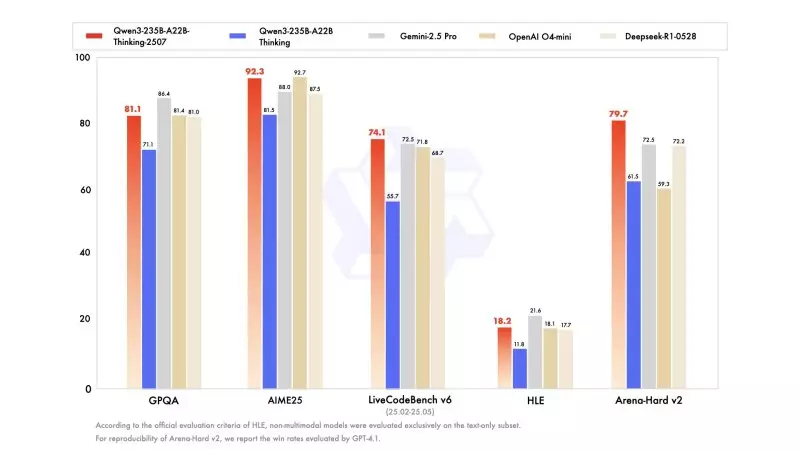In the rapidly evolving landscape of artificial intelligence, staying ahead necessitates more than incremental improvements; it demands groundbreaking innovations that challenge the status quo. Alibaba’s Qwen team has exemplified this spirit with a series of strategic releases that are shaping the future of open-source AI. Their recent deluge of models, culminating in the formidable Qwen3-235B-A22B-Thinking-2507, demonstrates a clear departure from conventional, proprietary AI development. Instead, they are forging a path toward an ecosystem where transparency, accessibility, and performance converge.
What sets Alibaba apart is their unwavering commitment to open licensing coupled with high-caliber performance. These models, licensed under Apache 2.0, break down barriers often erected by other industry giants. They empower organizations—big or small—to harness, modify, and deploy cutting-edge AI solutions without restrictive gatekeeping. This strategic move is not just about democratization of AI but about fostering an environment where innovation is driven openly by community collaboration instead of corporate opacity.
Moreover, these releases are not mere incremental upgrades; they are strategic leaps forward. The emphasis on creating specialized models for reasoning, coding, and translation reflects a nuanced understanding that AI applications are diverse and require tailored solutions. Alibaba’s approach indicates a mature vision—transforming open-source models from generic tools into highly optimized systems for real-world enterprise applications.
Leading the Charge with Reasoning-Driven Models
Among the multitude of innovations, the crowning achievement is undoubtedly Qwen3-235B-A22B-Thinking-2507. This reasoning-focused model epitomizes how AI can approach complex tasks with what can only be described as human-like reasoning capabilities. Its performance on benchmarks such as AIME25 and LiveCodeBench v6 underscores a new standard in problem-solving, logical deduction, and analytical prowess. It demonstrates that with carefully targeted training, open-source models can rival, if not surpass, their proprietary counterparts.
The model’s ability to engage in multi-step reasoning through “chains-of-thought” initiatives signifies an evolution in the architecture—moving from simple pattern matching to structured, reflective problem-solving. This capability is vital for applications demanding high accuracy and nuanced interpretation, such as scientific research, legal analysis, and strategic decision-making.
This shift reflects a deeper philosophical stance: AI models should not be simplified tools but capable thinkers. Alibaba’s separation of reasoning models from instruction-tuned variants highlights a strategic focus on specialization. By optimizing these models for their intended roles, the company is creating a more predictable and trustworthy ecosystem—one that mirrors the sophistication and depth needed for demanding enterprise deployments.
Unlocking Creative and Technical Potential with Diverse Specializations
The multi-faceted ecosystem Alibaba has assembled reflects their understanding that AI’s true strength resides in its versatility. Not only have they introduced a reasoning powerhouse with Qwen3-235B-A22B-Thinking-2507, but also a suite of models tailored for demanding coding workflows, translation, and general instruction-following.
Qwen3-Coder-480B-A35B-Instruct stands out as a testament to AI’s growing proficiency in complex programming tasks. Its ability to support a billion tokens of context and outperform established benchmarks such as GPT-4.1 Bob demonstrates that AI is quickly closing the gap—if not outright surpassing—human expertise in software development. This symbolizes a major shift in how technical teams can leverage AI as a co-creator rather than just a tool.
The multilingual model, Qwen3-MT, broadens the scope further. Supporting over 90 languages, it signifies a leap toward truly global AI applications—breakthroughs that are especially vital for international businesses, localization efforts, and cross-cultural communication. Its efficient, cost-effective inference model ensures that organizations in diverse sectors can deploy multilingual AI solutions without prohibitive expenses or infrastructure overhead.
What emerges from these diverse offerings is a vivid picture of an ecosystem designed to serve specific needs—be it logic, code, language, or instruction—each optimized and licensed for unrestricted enterprise use. This strategy not only enhances flexibility but also encourages innovation at the grassroots level, empowering developers and organizations to craft bespoke AI solutions grounded in a common, open foundation.
Championing Autonomy and Control in AI Deployment
Alibaba’s decision to release these models under Apache 2.0 licensing is a game-changer. In an era where AI dominance often depends on API-based access and proprietary systems, this open approach redefines what’s possible. By granting full rights for download, modification, and self-hosting, Alibaba effectively puts organizations in the driver’s seat—allowing them to design, deploy, and fine-tune models that address their unique challenges.
Furthermore, the accessibility offered through platforms like Hugging Face and ModelScope signals an inclusive future—one where research, business, and innovation are fluid and collaborative. Enterprises no longer need to be beholden to opaque API restrictions or costly services; instead, they can build, iterate, and control their AI infrastructure on their terms.
The practical side of this is equally compelling. With deployment options ranging from local inference to cloud-based API integration, companies can optimize their training and deployment pipelines for cost, latency, and privacy. The availability of lightweight variants such as the FP8 model for hardware-constrained environments ensures that even smaller organizations or startups can access state-of-the-art AI without massive capital investment.
This movement toward open, flexible AI infrastructure signals a fundamental shift in industry dynamics. Alibaba’s open models are poised to stimulate competition, innovation, and a broader democratization of AI development—ultimately improving the technological landscape by making advanced AI accessible, controllable, and versatile.

